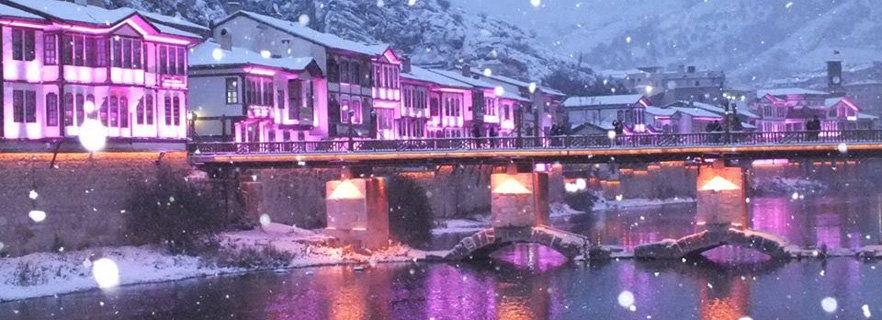 Amasya
Amasya
Amasya is located in the central part of the Black Sea Region. It is surrounded by Samsun from the north, Çorum from the west, Yozgat from the south and Tokat from the Southeast. 35 ° 00 'and 36 ° 30' east latitude, 40 ° 15 ', 41 ° 03' north latitude.
Amasya city is situated on two banks of this river in the part where the east-west direction of Yeşilırmak river is taken. The castle remains on the north coast of Yeşilırmak, the settlement between the royal tombs and Yeşilırmak is narrow and the settlement forms a thin strip. The main settlement and development area of the city is on the southern coast of Yesilirmak. The neighborhoods separated by Yeşilırmak are connected by 7 bridges on the river.
The prominence of the city of Amasya is that this city has been established in a narrow way. Yeşilırmak enters a valley hidden from the Amasya plain and after passing through the Ferhat Bosphorus. The reason why the city is located at the first place in every period should be related to this position.
It is convenient to place a narrow cut in the bottom of the valley. As the city developed, it developed towards the slopes of the valley, but due to its unfavorable position it was not possible to ascend more than the slopes; Which caused the city to spread longitudinally along the Yeşilırmak valley in the east-west direction. Thus, the city has managed to preserve its old core, no matter who it is.
Nowadays, the city preserves a vast hidden location and continues its existence as the only big city founded on a valley floor in Anatolia with a "V" shape. The development of the city, the economic reasons are not fast. This has helped the city to come up safeguarded daily. With this feature, Amasya is attractive from the point of view of tourism and attracts attention with its unspoiled cultural values.
Historical
In ancient times it is known that many Anatolian cities are gods or heroes of the founder (ktistes). This mythological establishment also applies to Amasya. ERMHC KTICAC THN located on an Amasya sankesi of the Roman Emperor Septimius Severus (M.S. 193-211) is considered to be the founding god of the city of Amasya of Hermes in the light of the inscription of THR POLIN.
If we come to the history of the name of Amasya after this brief explanation; According to the Hittite documents, the first known name of Amasya is supposed to be Hakmi [Khakm (p) is]. It is estimated that this name continued Persians until the conquest of Amasya. Amasya's name in the Kingdom of Mitridates is "Amasseia". Especially M. Ö. II. AMASSEIA is clearly seen in Amasya city coins that have been beaten since the beginning of the century. The geographer Strabon already uses the word Amaseia for Amasya. The word Amaseia refers to "Mother" and specifically refers to "Mother Goddess" and "Ma" and its variant "Ma". Moving from this, it can be said that Amaseia means "Mother Goddess Ma's city". Mother Goddess Ma is a goddess of eastern origin that became widespread after the conquest of Anatolia by Persians.
At the same time this goddess is the local goddess of Mitridates and Cappadocia. The word Amaseia is also a form of Hellenic rhetoric of the actual pronunciation of the time of the Persians. During the Roman period the name Amaseia was used as AMACIAC (Amasia) without much change. For example, we see the name of AMACIAC in Amasya city coins minted during the reign of Emperors Septimius Severus, Caracalla and Severus Alexander. It is known that the name of Amasia continued in the Byzantine Period unchanged. Amasya's name was sometimes known as Amasya and sometimes as City-i Harashna during the time of Danishmendlans. Seljuks, Ilkhanids, Emirates and the name of Amasya during the Ottoman Empire period did not change until daylight.

 Amasya
Amasya